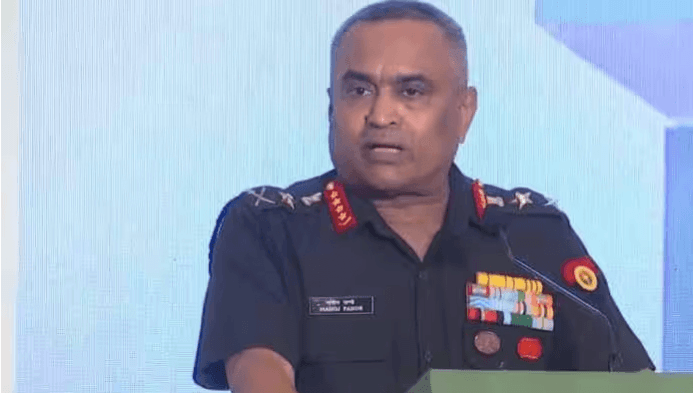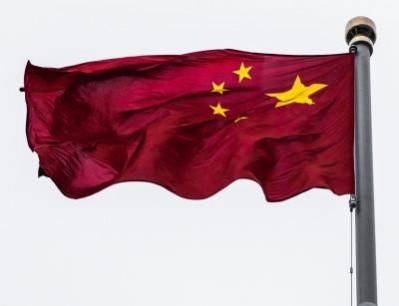Indian Army Chief General Manoj Pande delivered a scathing speech on China's tactics on how it aspires to become a global security provider. Gen Pande was delivering a keynote address at the inaugural session of the two-day strategic dialogue in Pune on the subject of "Rise of China and its implications for the world" in Pune. The current Chief of Army Staff did not mince any words as he exposed the "totalitarian" regime that is China.
Gen Pande gave examples of the peace deals it is brokering between Saudi Arabia and Iran and Russia and Ukraine. Through these acts, the General said that China wants to replace the United States to become a global net security provider.
"China's rise is driven by its regional and global aspirations for a much larger and higher seat at the high table. The Chinese urgency to replace the US as the global net security provider is reflected in the brokering of peace talks between Saudi Arabia and Iran, as well as the presentation of the Chinese 12-point peace plan for ending the ongoing Russia-Ukraine conflict," Gen Pande said.

He further added that "The ongoing Russia-Ukraine conflict has only added to the turbulence in the landscape with many aspects emerging profoundly in the geopolitical security calculus. The relevance of hard power has been reaffirmed along with the primacy of the land in determining the victory markers and the imperative to be prepared for the long haul."
The Army chief noted that the current engagement mechanisms exist at the political, diplomatic and military levels, which are utilised to ensure stability along the LAC. "China has over the years accrued significant capacities for force mobilisation, application and sustenance of military operations. Consequent to the development of infrastructure of military significance- be it roads, airfields, helipads and or belating structures," he said.
Referring to China's regime as a "totalitarian state", the General said it has "given shape to an institutionalized, civil-military ecosystem, which aims to harness technology, knowledge, governance, and infrastructure to meet security requirements. With such tech-enhanced capabilities, China can and is accruing national security advantages for itself while posing a threat to its competitors and adversaries."

"China is increasingly displaying the willingness to project its military power, from its aggressive attempts in establishing a military base in the Indo-Pacific, Africa and, more importantly, in our immediate neighborhood. The proliferation of its military weapons equipment technology is enhancing military capabilities in a number of states, some in South Asia too, which is of concern," he said.
Gen Pande highlighted the current geopolitical situation in the South Asian region, including unresolved border disputes as well as vulnerability to climate disasters.
"South Asia is one of the least economically integrated entities in the world, resulting in security and economic imbalances in the region. We may visualise strategic neighborhood as an arch of uncertainty. Unresolved border disputes both territorial as well as maritime, illegal cross-border migration, non-traditional threats such as illegal and unregulated fishing and increasing religious fundamentalism coupled with regional vulnerability to climate-change-induced disaster are going to keep South Asia region in flux," Army Chief General Manoj Pande said.
"These manifestations certainly have an impact on our national security. It is amidst this background that China's rise continues. It is driven by its regional and global aspirations. China's rise as a political, technological and military power has accorded it a new hierarchical position in the world order which it intends to lead.," he added.
Below is the transcript of General Manoj Pande's full speech:
Professor Prof. (Dr.) Karbhari Vishwanath Kale, vice chancellor - Savitribai Phule Pune University, Prof. (Dr.) Vijay Khare, dean - faculty of humanities, and head - department of defense and strategic studies, Dr. Jayadeva Ranade, president, Center for China Analysis and Strategy, distinguished scholars, esteemed guests, veterans, colleagues in uniform, students of SPPU, ladies and gentlemen, very good afternoon and Jai Hind to each one of you.
It's always good to be back here in Pune, and a privilege to speak at this esteemed institution, which honors and upholds the values of Savitribai Phule, who devoted her life to promoting women's rights and empowerment. Her noble pursuits truly embodied the ideals of our present day nari shakti [women power] initiatives. She indeed was a visionary ahead of her times. My compliments to Mr. Jayadeva Ranade of the Center for China Analysis and Strategy, which has been pioneering study, research, and analysis on China. Your role in providing insights into China's military capabilities, modernization, and strategic thoughts is indeed noteworthy and commendable.
For today's talk on the theme of rise of China and its implications for the world, I intend to share my thoughts firstly on the overall strategic context in which China's rise needs to be seen; secondly, I'll focus on China's rise per se, followed by implications of China's rise on our regional and operational environment, and finally how are we addressing this challenge.
So, let me begin with the overall strategic context. In today's world geoeconomics continues as the lead driver of geopolitical shifts. Complex global relationships are taking shape, driven by an interplay of interests, concerns, and aspirations. The resultant power plays range from cooperation to competition and containment to confrontational strategies. Consequently, strategic linkages are being redrawn as interest-based alliances. Traditional partnerships are under stress due to cost, duration, and level of support. The bottom line in all these parlays reflects the primacy of one's national interests.
The ongoing Russia-Ukraine conflict has only added to the turbulence in the landscape, with many aspects emerging profoundly in the geopolitical security calculus. The relevance of hard power has been reaffirmed, along with the primacy of land in determining victory markers, and the imperative to be prepared for the long haul. But for the nuclear domain the saber-rattling for which did figure for some time, the war has spanned the entire spectrum of conflict with grey-zone aggression factored in as an increasingly preferred strategy of conflict prosecution.
This conflict, in fact, has been a watershed for technology, which has emerged as the new strategic arena of geopolitical competition. Concurrent developments in disruptive and dual-use technologies like quantum computing, artificial intelligence, nanotechnology, 3D printing, robotic exoskeletons, along with the progression in kinetic instruments like hypersonic weapons, high-power lasers, swarm drones, autonomous systems, manned-unmanned teams etc. are making the battlespace more complex, contested, and lethal.
South Asia is one of the least economically integrated entities in the world, resulting in security and economic imbalances in the region. We may visualize our immediate strategic neighborhood as an arc of uncertainty. Unresolved border disputes — both territorial as well as maritime — illegal cross-border migration, transnational crimes, non-traditional threats such as illegal and unregulated fishing, piracy, and increasing religious fundamentalism, coupled with regional vulnerabilities to climate change-induced disasters are going to keep the South Asian region in a flux. These manifestations certainly have an impact on our national security.
It is amidst this background that China's rise continues. It is driven by its regional and global aspirations as also impacted by [...] dynamics. Let me briefly dwell on the relevant markers of the rise of China.
China's rise as a political, technological, and military power has accorded it a new hierarchical position in the world order, which it intends to lead. China's strides as a political powerhouse are evident in its pursuits for a much larger and higher seat on the high table. Brokering of peace talks between Saudi Arabia and Iran, and putting forth the Chinese 12-point peace plan for ending the ongoing Russia-Ukraine conflict is reflective of a Chinese urgency to replace US as the global net security provider. It is also attempting to gain clout in international organizations, which were traditionally dominated by Western nations. The means though remain through steady acquisition of key official positions, use of economic leverages, and aggressive wolf-warrior diplomacy or bullying tactics.
China advocates its political system as a democracy that works, distinct from western practices of democracy. It defines this as social democracy. The prosperity quotient of Chinese citizens, their higher requirements of material and cultural life, and the economic heft of the nation today are put forth as proof of efficiency of their model. The essence of their belief in the same is reflected in the words of Xi Jinping and I quote, "we have every confidence that we can give full play to the strengths and distinctive features of Chinese socialist democracy and make China's contribution to the political advancement of mankind."
Its multi-pronged strategy entails, on the one hand, support to international institutions and agreements that seem aligned to its goals and norms. Yet on issues of divergence such as human rights, it seeks to undermine such values and create alternative institutions and models. In domains where norms and institutions are still being established, such as internet governance, it works with like-minded regimes to create standards that reflect their interests.
The era wherein Deng Xiaoping propounded "hide your strength and bide your time" is indeed over. In fact, the work report presented by Xi Jinping at the 20th Party Congress in October last year is a first-hand account of China's approach on everything from economic policy to diplomacy in pursuit of the great rejuvenation of the Chinese nation. A key take-away was China's willingness to use force to incorporate Taiwan into the People's Republic, which was unambiguously articulated in the document as, and I quote, "we will never promise to renounce the use of force and we reserve the option of taking all measures necessary."
In effect, all its actions on the global geopolitical canvas reflect a Sino-centrist worldview of it being the Middle Kingdom and, therefore, rightly deserves to be seen as the cultural, political, and economic center of the world.
China's growth in the economic domain is unprecedented. Within a few decades of initiating widespread reforms, it transitioned from a largely agrarian economy into a wold leader in manufacturing and services sector. Due to its industrial prowess, it had also earned a name for itself as the world's factory. Following the success of China, many developing countries and their leaders have looked to emulate China. Today, it stands as the largest economy in purchasing power parity terms. Its economic rise, however, is also multifaceted.
On the one hand, it is building an international network of coercion through predatory economics while, on the other, it claims pulling out more than 100 million of its own people out of poverty. Its pursuit to expand the sphere of influence through economic manoeuvring, weaponization of resource supply chains, financing large infrastructure projects with scant regard for environmental and safety standards, and saddling recipient countries with unsustainable debt are there for the world to see.
Issues of concern also continue to exist in cases of theft of intellectual property rights, stealing trade secrets and technology from foreign companies, as also its unfair trade practices.
China's technological pursuits have been characterized by systemic efforts to acquire technologies from the West. This also entailed aggressively luting or poaching scientists and researchers from the West with unrestricted funding offers. Consequently, today China has established a vast lead in high-impact research across majority of emerging technology domains of defense, space, robotics, energy, biotechnology, Al, advanced materials, hypersonic systems, 6G, and quantum technology. For some of these domains, all of the world's top 10 lead research institutions are based in China, and are collectively generating more high-impact research papers than any other country. China today is the world leader in patent applications.
The Chinese by virtue of being a totalitarian state have given shape to an institutionalized, civil-military ecosystem, which aims to harness technology, knowledge, governance, and infrastructure to meet security requirements. With such tech-enhanced capabilities, China can and is accruing national security advantages for itself while posing a threat to its competitors and adversaries.
China's economic transition and technological progression has given it the capability to emerge as a major military power. Concurrent to its military rise, its strategic doctrines, too, have seen various shades from a war-zone concept of fighting a limited war under high-tech conditions to the three- warfares approach entailing public opinion, psychological warfare, and legal warfare — and, of late, to that of an unrestricted warfare with conventional capacities being available to effect massive destruction of an adversary.
The continued focus on technology and specifically Al into its military warfighting systems and doctrines is evident from the 19th Party Congress report. It urged PLA to accelerate the development of military intelligentization, entailing not only integrating Al into existing warfighting functions but to use it to shape a new cognitive domain, and revolutionize their approach to warfighting. This was also reflected in its 2019 defense white paper, which propagated fighting and winning intelligentized wars.
In the response context, it is also prudent to recognize China's grey-zone actions, which involve kinetic and non-kinetic forms of assertiveness and coercion aimed at achieving strategic goals without provoking a conflict. Selective historical referencing, intelligent obfuscation of reality using legal framework, and exploiting technological prowess in cyber and information operations are some of the common tools in the Chinese playbook.
It is increasingly displaying a willingness to project its military power as seen from its aggressive attempts, establishment [of] military bases in the Indo-Pacific, Africa, and more importantly in our immediate neighborhood as well. The rapid expansion of PLA Navy is reflective of its extra regional power projection intentions. The proliferation of its military weapons equipment and technology is enhancing military capabilities of a number of states — some in South Asia too — which is of concern. Its forays in the South China Sea, rejection of international tribunal awards on maritime claims, activities in the Taiwan Strait, and actions along the LAC [Line of Actual Control] bordering on bellicosity make it increasingly apparent that China's interpretation of an international rules-based order rests on "might is right."
Apart from the issues that I have briefly spoken of, there are aspects where its pursuits seem to be in congruence to global norms. The establishment of the multilateral financial institution the Asian Infrastructure Investment Bank, which invests in infrastructure projects across Eurasia, does follow international lending standards and often cooperates with the World Bank and the ADB. On climate change norms, its stance has shifted from resisting international cooperation in the yesteryears to one of reducing usage of oil fuels, fossil fuels and becoming the world's biggest investor in renewable energy.
Having seen the key facets of China's rise, let me focus on the regional geostrategic context and operational environment closer home as relevant to us. In the Indo-Pacific, a shift of global power- play is distinctly discernible in the recent years. Geopolitical relevance and geoeconomic weight of the Indo-Pacific nations have only augmented the geographic indispensability of this region to world maritime trade — and that of China in particular.
China's assertion in this region has been reflected most profoundly in its claims on disputed islands in the South China Sea, followed by unilateral actions to build military facilities. The significance it attaches to these occupations is reflected in their definition of the same as core interests and non-negotiable.
China's resolve for reunification of Taiwan was reflected once again in the white paper published post-Nancy Pelosi's 2022 visit to Taiwan, which reiterates China's stand as a shared aspiration for all the sons and daughters of Chinese nation, and an historic mission of the Chinese Communist Party.
China's engagement with ASEAN has largely focused on economic development and domains of non-traditional security. It also seeks to create an alternative architecture of rules and institutions on the basis of shared beliefs and norms that can be identified as a community of shared destiny.
India's strategic location astride the vital sea lines of communication propels us as a key player in the Indo-Pacific contestations. In contrast to Chinese strategy unfolding in the Indo-Pacific, our strategy has been defined in our vision of the Indo-Pacific as Security and Growth for All in the Region — the essence of which can be found in the words of our honorable prime minister who said and I quote, "when the oceans are open, the seas are secure, countries are connected, the rule of law prevails and the region is stable, nations small and large prosper as sovereign countries."
I would like to make a mention here of the strategic architectures taking shape in the Indo-Pacific. The evolution of [the] Quad is testimony to increased opportunities, responsibilities, as well as challenges for us in this expanded strategic horizon in the future. China's views on [the] Quad are complex, reflecting its broader concerns about the balance of power in the Indo-Pacific region. China has criticised the Quad as a Cold War relic and accused member countries of pursuing a security alliance to undermine China's interests. Concurrently, China has also downplayed the significance of the Quad, describing it as an artificial grouping that lacks coherence and is unlikely to have a lasting impact on the region.
While Quad linkages will get augmented in the years ahead, core interests of individual nations will reign supreme over providing active military support to us in case of a conflict with our adversary. This necessitates the need for India to be self-reliant in our needs to protect national interest.
In South Asia, amongst the developing countries, we have those with counter pressures between political aspirations, domestic needs, and economic capacity. These often have fallen prey to Chinese economic traps. Examples in our neighborhood are there for us to see. The lead example has been the flagship corridor of BRI, the CPEC, which continues to be mired in issues of lack of transparency, accountability, security, and the ability or inability of Pakistan to pay off the loans. In addition to Pakistan, it is also leveraging its political economic heft on other neighbors, such as Nepal, Bhutan, Myanmar, Sri Lanka, Maldives, and Bangladesh, to accrue increased influence quotient for itself in the South Asian geostrategic canvas.
Chinese attempts to establish military footprints across South Asia are common knowledge. Now, of late, its power projection into the Indian Ocean has only enhanced with increased forays of the PLA Navy.
In a sense, China's geopolitical and geostrategic design in this region can be termed to entail shaping perspectives through coercion in its belief that tributary states need to observe hierarchy.
From the issues that I have spoken thus far, certain key aspects emerge as implications for the world. Firstly, China intends to challenge the world order led by the US and aims to emerge as the leading superpower. Secondly, with the economic heft and the supply chain dependencies and leverages it has accrued for itself, it is capable of unfolding a brute-force economic policy, making geopolitical and trade engagements into zero-sum games.
In the political domain, the steady creep to hold the leadership position in top international institutions and its displayed stands as a member of the UN Security Council reflect an intent to control world policies. In some cases, parallel organizations too are being formed congruent to China's requirements and geoeconomic strategies.
It also suggests increased cogency between China's foreign policy and military prowess in the prosecution of China's aggregate national interest. As a leader in niche technology R&D, it has accrued for itself the capabilities to retain a dominating and dictating position in myriad of domains where technology is an enabler.
Next is the increasing belligerence stemming out of both economic and military power. Increasingly evident attempts by China and its propensity to project power outside its region portend a threat to the rules-based international order. Leveraging of its military power to settle disputes, regain territories to which it stakes claim, and establish new footprints to safeguard its interests has serious implications in the global security canvas.
Last, but not the least, with the comprehensive national power it has secured for itself it is certainly in a position to establish strategic partnerships, dictate regional geopolitical developments, shape major world event outcomes by weaponization of instruments, linkages, dependencies and conditional support.
I wish to spend some time talking about the current operational environment and the situation. I think the most important aspect of our operational environment remains our legacy challenges of unsettled and disputed borders. Pockets of disputes and contested claims to territory continue to exist due to differing perceptions of the alignment of the Line of Actual Control. Transgressions remain a potential trigger for escalation. Border management hence requires close monitoring as infirmities in border management can lead to wider conflict.
As you all know, we have four agreements and protocols of 1993, 1996, 2005, and 2013 in the military domain to maintain peace and tranquility on the LAC. Of concern remains the violation of these by China, with their attempt to carry out transgressions across the LAC.
The boundary issue cannot be divorced from bilateral relations, and this is amply reflected in the statement by our external affairs minister Dr. Jaishankar who said, and I quote, "for ties to return to a positive trajectory and remain sustainable, they must be based on three mutuals: mutual sensitivity, mutual respect, and mutual interest. ..and I reiterate that the state of [the] border will determine the state of the relationship."
The current engagement mechanisms exist at the political, diplomatic, and military levels, which are being optimally utilized to ensure stability along the LAC. Talks are continuing under these established mechanisms.
China has over the years accrued significant capacities for force mobilization, application, and sustenance of military operations consequent to development of infrastructure of military significance be it troops, airfields, helipads, or billeting structures.
The Indian army's strategic orientation and long-term capability development has been a focus on the northern borders. We have carried out the required rebalancing of forces to effect the desired response metric on the northern borders. We have adequate reserves and are prepared to deal with any contingency. Our preparedness remains of a higher order, and troops continue to deal with the PLA in a firm, resolute, and measured manner while ensuring the sanctity of our claims. We have ramped up our efforts to fructify the operationally critical infrastructure and logistic requirements, especially the forward area roads. The Indian army is working in synergy with all agencies in the forward areas to upgrade the infrastructure.
If one was to give a prognosis on the subject from India-China perspective, some key issues come to fore.
India has today emerged as a significant player in the global stage. Today we are the voice of the Global South, with our growing economy, technological advancements, and strategic partnerships with other nations. Our soft power, cultural diversity, and democratic values also contribute to our rising influence on the world stage. As former U.S. President Barack Obama once said, and I quote, "India will play a defining role in the 21st century as a responsible global power." That statement itself acknowledges India's potential as a leading nation in the world, and its ability to shape the course of global affairs, and is a testament to its resilience, innovation, and commitment to progress.
India-China bilateral ties do stand influenced by the great power rivalry currently playing out between China and the US. The Chinese strategic community and leadership view India's relations with the US as aimed at balancing China. Former secretary Vijay Gokhale notes in his paper that the correlation between the growing strategic relationship between Delhi and Washington and the deteriorating ties between Delhi and Beijing seemed to bear out the basic premise that China sees India mostly through the lens of China's relationships with the United States, Russia, and other powers.
Major powers today appear ready to take the China issue head-on. The US-China contestation is sharpening by the day and Europe, too, is reevaluating its ties with China. Western powers ate claiming bigger stakes in the Indo-Pacific and partnering with states in the region to provide an alternative to Chinese hegemony.
2023 in fact will be a watershed year for India in global policymaking. With the presidency of G20, India shall play an important role in finding pragmatic global solutions for the well-being of all and in doing so manifest the true spirit of IVasudbaiva Kutumbakam. The SCO presidency provides us an opportunity to further strengthen our ties with Russia and other Central Asian republics [and?] accrue the required counterbalances in the security canvas.
The relations between the two countries essentially need to hinge on the principle of mutuality. To ensure peace along the LAC adherence to existing protocols and agreements are a sine qua non. LAC needs to be respected, and disputes should be resolved through established mechanisms and not through the unilateral application of force by troops on ground to alter the status quo.
Maintaining peace and tranquility on the borders forms the key basis of development of relations in other fields. The situation along the LAC needs to return to normal, and status quo must be restored before the bilateral relations can move forward.
Both sides need to be sensitive to the aspirations and interests of the other side as the 2nd and the 5th largest economies of the world. As we seek to narrow our divergences and manage our differences, understanding the long-term perspective is extremely essential.
If one were to dwell specifically on China's rise and predictions that it would soon effect a unipolar world, I would like to quote again from our external affairs minister who said, and I quote, "the rise of China, the share of China in global economy, in global technology, in global influence — these are undeniable factors. But the fact is that in this decade you are clearly going to see many more powers who will have more influence on global debates and global outcomes than they did before. Some of them would be sufficiently separated from the rest of the herd to be seen as a pole, and therefore you will have multipolarity."
Speaking specifically about the Indian army, I would like to highlight the steps taken by us to address this challenge or the imperatives in light of the security implications I have covered in my talk earlier.
We intend to enhance our operational preparedness and increase efficiency in functional and administrative domains towards becoming a more modern, agile, adaptive, and technology enabled, future-ready force. Our road map to achieve this entails undertaking transformations that stand on the edifice of five pillars, first of which is force optimization and restructuring. Second is modernization and technology infusion. The third is modifying, refining, improving our systems, processes, and functions. Fourth is human resource management. And the 5th is improving jointness, and integration among the three services.
As part of force restructuring and optimization endeavor, our intent is to reshape our organizational structures from the perspective of a future needs for achieving a better combat-responsive metric. We are making a transition from a manpower-intensive army to a technology-driven one.
Under the modernization and technology infusion endeavor, major initiatives are currently underway to transform ourselves into a modern technology-driven, atmanirbhar [self-reliant], and battle-ready force. Provisioning modern weapons and equipment, and leveraging niche technologies is intrinsic to this effort for which the Indian army is committed to find indigenous solutions.
The next transformational pillar entails efforts to enhance the efficiency of our systems, processes, and functions. Technology again is being leveraged to augment effectiveness and outcomes through automation, digitization, and networking.
In the human resource management domain, a path-breaking and progressive initiative has been taken through the implementation of the Agneepath scheme, which is progressing well.
As part of our fifth pillar of transformation, our pursuit to jointness and integration with the other sister services remains an enduring one. The cross-linkages are being nurtured so as to aggregate our capacities and capabilities in a much better manner.
To conclude, I would like to say that today our nation reflects a confident optimism about the future, with our growing economy, military, and diplomatic capabilities. As the nation's influence expands, new challenges are bound to build up. Some will question our rise, some will contest it, and others will attempt to compete. As a nation, we need to ensure that our national interests remain paramount, and we unfold our strategies to secure and further our national interests.
I would like to assure everyone present here the Indian army is well-trained, equipped, combat-hardened, and well-prepared to take on any security threat or challenge that may come the nation's way.
In the end, I wish the Savitribai Phule Pune University and the Centre for China Analysis and Strategy all the very best in their future endeavors.

















